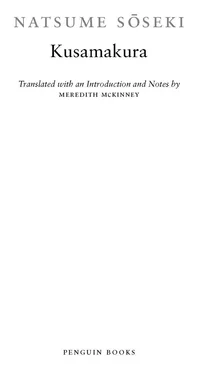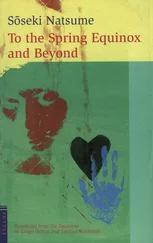Natsume Soseki - Kusamakura
Здесь есть возможность читать онлайн «Natsume Soseki - Kusamakura» весь текст электронной книги совершенно бесплатно (целиком полную версию без сокращений). В некоторых случаях можно слушать аудио, скачать через торрент в формате fb2 и присутствует краткое содержание. Жанр: Старинная литература, на английском языке. Описание произведения, (предисловие) а так же отзывы посетителей доступны на портале библиотеки ЛибКат.
- Название:Kusamakura
- Автор:
- Жанр:
- Год:неизвестен
- ISBN:нет данных
- Рейтинг книги:4 / 5. Голосов: 1
-
Избранное:Добавить в избранное
- Отзывы:
-
Ваша оценка:
- 80
- 1
- 2
- 3
- 4
- 5
Kusamakura: краткое содержание, описание и аннотация
Предлагаем к чтению аннотацию, описание, краткое содержание или предисловие (зависит от того, что написал сам автор книги «Kusamakura»). Если вы не нашли необходимую информацию о книге — напишите в комментариях, мы постараемся отыскать её.
Kusamakura — читать онлайн бесплатно полную книгу (весь текст) целиком
Ниже представлен текст книги, разбитый по страницам. Система сохранения места последней прочитанной страницы, позволяет с удобством читать онлайн бесплатно книгу «Kusamakura», без необходимости каждый раз заново искать на чём Вы остановились. Поставьте закладку, и сможете в любой момент перейти на страницу, на которой закончили чтение.
Интервал:
Закладка:
I take myself off to the bathhouse in my night robe and dreamily float there with my face barely above the water for five minutes or so, feeling inclined neither to wash nor to leave. Why did I find myself in such a strange state last night? How extraordinary that the world should tumble head over heels like that between day and night!
Drying myself is too much of an effort, so I leave it at that and go back to the dressing room stil dripping. But when I slide open the bathhouse door from within, another shock greets me.
“Good morning. I hope you slept wel .†The words are almost simultaneous with my opening the door. I had no idea anyone was there, so this sudden greeting takes me completely by surprise, and before I can produce any response, the voice continues, “Here, put this on.†The owner of the voice steps around behind me, and a soft kimono is slipped over my shoulders. At last I manage “Why, thank you . . . ,†turning as I speak, and as I do so the woman takes two or three steps back.
The supreme effort that goes into describing the features of a hero or heroine has long been a determiner of a novel’s worth. Were one to enumerate al the words, in every language of East and West from classical times until today, that writers have devoted to evaluating the qualities of beautiful women, the list may wel rival in length the complete canon of the Buddhist sutras. How many words would it take, I wonder, if I were to select from among this truly dismaying assemblage of adjectives those that might best describe the woman now standing three paces away, twisting her body diagonal y to look at me out of the corner of her eye, comfortably taking in my astonishment and bewilderment?
In my thirty-some years I have never until this moment seen such an expression as is on her face. The ideal of classical Greek sculpture, I understand, can be summed up in the phrase “poised containment,†which seems to signify the energy of the human form held poised for action. The resonance of such a figure subtly inheres in that moment before the figure moves and changes into unguessable energies, swirling cloud or echoing thunder, which is surely why the significance of that form stil reaches us across the centuries. Al the dignity and solemnity to be found in the world lies hidden beneath this quality of poised containment. Once the figure moves, what is implicit becomes revealed, and revelation inevitably brings some resolution into one thing or another. Any resolution, of course, wil always contain its own particular power, but once the movement has begun, matters wil soon degenerate into mere sludge and squalor, and there wil be no going back to the harmonious serenity of the original form. For this reason, whatever has motion is always final y vulgar. The fierce sculptures of the temple guardians that Unkei created, or the lively cartoon figures of Hokusai, both ultimately fail for this simple reason.9 Should we depict motion or stil ness?—this is the great problem that governs the fate of us artists. The majority of the words used down the centuries to describe beautiful women can surely also be placed in either one of these two great categories.
But when I look at the expression of the woman before me, I am at a loss to decide to which category it belongs. The mouth is stil , a single line.
The eyes, on the other hand, dart constantly about, as if intent on missing nothing. The face is the classic beauty’s pale oval, a little plump at the chin, replete with a calm serenity, yet the cramped and narrow forehead has a somehow vulgar “Mount Fuji†widow’s-peak hairline. The eyebrows tend inward, moreover, and the brow twitches with nervous irritability; but the nose has neither the sharpness of a frivolous nature nor the roundness of a dul one—it would be beautiful painted. Al these various elements come pressing incoherently in upon my eyes, each one with its own idiosyncratic character. Who can wonder that I feel bewildered?
Imagine that a fault appears in the earth where once stil ness has reigned, and the whole begins to move. Aware that movement is contrary to its original nature, it strives to return to its original immobility; yet once unbalanced, momentum compels it to continue its motion, so that now we see a form that from sheer despair chooses to flaunt the movement enforced on it. Were such a form to exist, it would serve precisely to describe the woman before me.
Thus, beneath the derision evident in her features, I sense the urge to reach out and cling. From within the superficial mockery glimmers a prudent wisdom. For al the bravado that suggests her wit and spirit would be more than a match for a hundred men, a tender compassion wel s in its depths. Her expression simply has no consistency; in the appearance she presents, enlightenment and confusion dwel together, quarreling, beneath the one roof. The singular lack of any impression of unity in this woman’s face is proof of an equivalent lack of unity in her heart, which is surely owing to a lack of unity in her world. It is the face of one compel ed into misfortune, who is struggling to defeat that misfortune.
Unquestionably she is an unhappy woman.
Bowing slightly, I repeat my thanks.
In reply, she laughs briefly. “Your room has been cleaned.
Go and see. I’l cal on you later.†No sooner has she spoken than she twists swiftly about and lightly runs off down the corridor. I watch her go.
Her hair is up in the simple butterfly-wing ichogaeshi style, and below the sweep of hair a white neck is visible. It strikes me that the black satin weave of the obi at her waist would be only a facing.
CHAPTER 4
When I return, dazed, to my room, I see that it has indeed been beautiful y cleaned. The previous night’s events stil rather disturb me, so I open the cupboard just to check. Inside stands a smal chest, and from the top drawer a yuzen -dyed soft obi is half tumbled out, suggesting that someone has seized a piece of clothing in haste and quickly departed. The upper part of the obi is hidden from view beneath al uringly gaudy clothing. To one side is a smal pile of books. Topmost are a volume of the Zen master Hakuin’s sermons and the first volume of The Tales of Ise. 1
That apparition of the previous night may wel have been real.
Idly plumping myself down on a cushion, I discover that my sketchbook has been placed on the elegant imported-wood desk, careful y laid open with the pencil stil tucked between its pages. I pick it up, wondering how those poems I feverishly jotted down in the night wil read the next morning.
Beneath the poem
The maddened woman
setting the dewdrops trembling
on the aronia.
someone has added
The crow at dawn
setting the dewdrops trembling
on the aronia.
Because it is written in pencil, I can gain no clear sense of the writing style, but it looks too firm for a woman’s hand and too soft for a man’s. Here’s another surprise!
Looking at the next poem,
Shadow of blossoms
shadowed form of a woman
hazy on the ground.
I see that the person has added below it
Shadow of blossoms
shadowed form of a woman
doubled and overlaid.
Beneath
Inari’s fox god
has changed to a woman’s shape
under the hazed moon.
is written
Young Yoshitsune
has changed to a woman’s shape
under the hazed moon.2
I tilt my head in puzzlement as I read, at a loss to know whether the additions are intended as imitations, corrections, elegant poetic exchanges, foolishness, or mockery.
“Later,†she said, so perhaps she is about to appear with my breakfast. Once she’s here, I’l probably be able to make a little more sense of things. Happening to glance at my watch, I see it’s past eleven. How wel I slept! Given the lateness of the hour, I’d be better off making do with only lunch.
Читать дальшеИнтервал:
Закладка:
Похожие книги на «Kusamakura»
Представляем Вашему вниманию похожие книги на «Kusamakura» списком для выбора. Мы отобрали схожую по названию и смыслу литературу в надежде предоставить читателям больше вариантов отыскать новые, интересные, ещё непрочитанные произведения.
Обсуждение, отзывы о книге «Kusamakura» и просто собственные мнения читателей. Оставьте ваши комментарии, напишите, что Вы думаете о произведении, его смысле или главных героях. Укажите что конкретно понравилось, а что нет, и почему Вы так считаете.












